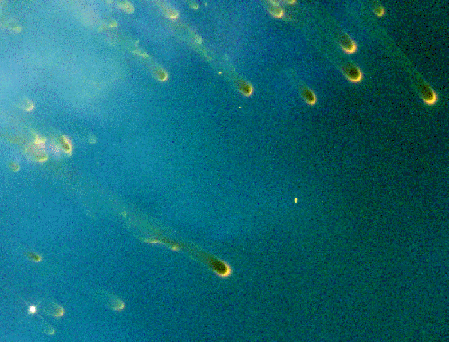
|
Credit & Copyright: R. O'Dell and K. Handron
(Rice University),
NASA
Explanation:
Four hundred fifty light-years from Earth, the wind from a
dying,
sun-like star produced a planetary nebula popularly known as
the Helix.
While exploring the Helix's gaseous envelope with the Hubble Space
Telescope (HST), astronomers
discovered indications of 1,000s of striking
"cometary knots" like those shown above.
So called because of their resemblence
to comets, they are actually much larger -
their heads are several billion miles across (roughly twice the size of the
our solar system itself) while their tails, pointing radially away from
the central star, stretch over 100 billion miles.
Previously known from
ground based observations,
the sheer number of cometary knots found
in this single nebula is astonishing.
What caused them to form?
Hot, fast moving shells of nebular gas overrunning cooler, denser,
slower shells ejected by the star during an earlier expansion may produce
these droplet-like condensations as the two shells intermix and fragment.
An intriguing possibility is that instead of dissipating over time,
these objects, could collapse and form
pluto-like bodies.
If so, these icy worlds created near the end of a star's life,
would be numerous in our galaxy.
Information:
The
Scale of the Universe Debate in April 1996
|
January February March April May June July August September October November December |
| ||||||||||||||||||||||||||||||||||||||||||||||||
NASA Web Site Statements, Warnings, and Disclaimers
NASA Official: Jay Norris. Specific rights apply.
A service of: LHEA at NASA / GSFC
& Michigan Tech. U.
Based on Astronomy Picture
Of the Day
Publications with keywords: Helix Nebula - cometary globule
Publications with words: Helix Nebula - cometary globule
See also:
